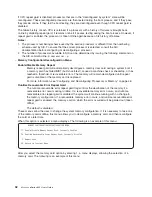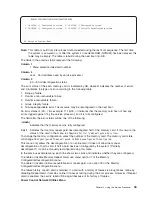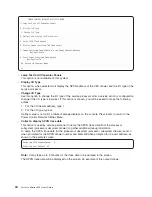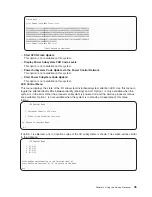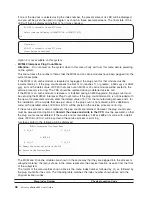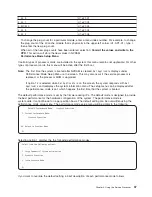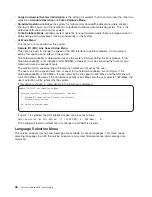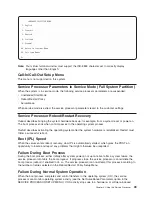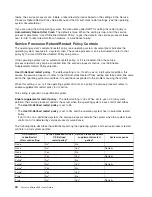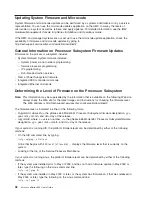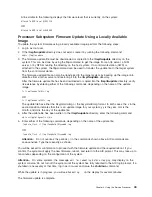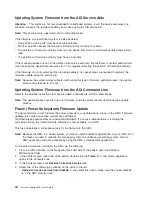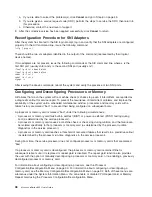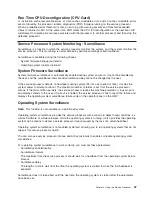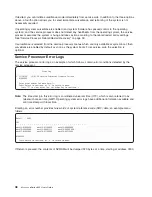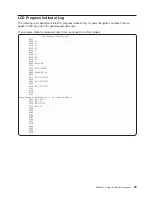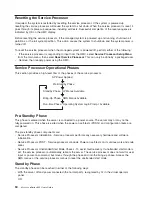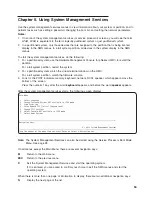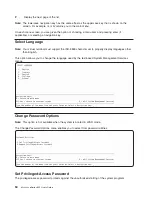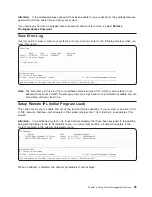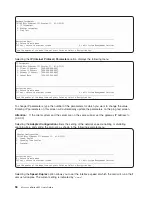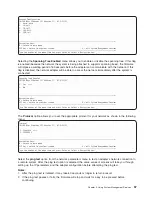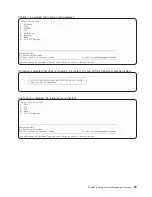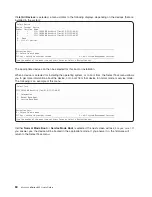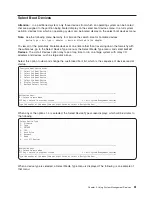
a.
If
you
are
able
to
correct
the
problems(s),
click
Cancel
and
go
to
Step
6
on
page
45.
b.
If
you
are
given
a
service
request
code
(SRC),
perform
the
steps
to
service
the
SRC,
then
return
to
this
procedure.
c.
Otherwise,
contact
the
next
level
of
support.
8.
After
the
corrective
service
has
been
applied
successfully,
click
Cancel
to
return.
Reconfiguration
Procedure
for
SNI
Adapters
After
the
system
has
booted
to
the
AIX
login
prompt,
log
in
and
verify
that
the
SNI
adapters
are
configured
properly.
On
the
AIX
command
line,
issue
the
following
command:
lscfg
|
grep
sni
There
should
be
two
sni
adapters
identified
in
the
output
of
the
command
(represented
by
their
logical
device
names).
If
two
adapters
are
not
present,
issue
the
following
commands
at
the
AIX
command
line,
where
x
is
the
first
SNI
port
(usually
sni0)
and
y
is
the
second
SNI
port
(usually
sni1)
ifconfig
-d
snix
down
detach
ifconfig
-d
sniy
down
detach
rmdev
-d
-l
snix
rmdev
-d
-l
sniy
cfgmgr
-v
After
issuing
the
above
commands,
reboot
the
system
and
verify
the
presence
of
two
SNI
ports.
Configuring
and
Deconfiguring
Processors
or
Memory
All
failures
that
crash
the
system
with
a
machine
check
or
check
stop,
even
if
intermittent,
are
reported
as
a
diagnostic
callout
for
service
repair.
To
prevent
the
recurrence
of
intermittent
problems
and
improve
the
availability
of
the
system
until
a
scheduled
maintenance
window,
processors
and
memory
cards
with
a
failure
history
are
marked
″
bad
″
to
prevent
their
being
configured
on
subsequent
boots.
A
processor
or
memory
card
is
marked
″
bad
″
under
the
following
circumstances:
v
A
processor
or
memory
card
fails
built-in
self-test
(BIST)
or
power-on
self-test
(POST)
testing
during
boot
(as
determined
by
the
service
processor).
v
A
processor
or
memory
card
causes
a
machine
check
or
check
stop
during
runtime,
and
the
failure
can
be
isolated
specifically
to
that
processor
or
memory
card
(as
determined
by
the
processor
runtime
diagnostics
in
the
service
processor).
v
A
processor
or
memory
card
reaches
a
threshold
of
recovered
failures
that
results
in
a
predictive
callout
(as
determined
by
the
processor
run-time
diagnostics
in
the
service
processor).
During
boot
time,
the
service
processor
does
not
configure
processors
or
memory
cards
that
are
marked
“bad.”
If
a
processor
or
memory
card
is
deconfigured,
the
processor
or
memory
card
remains
offline
for
subsequent
reboots
until
it
is
replaced
or
repeat
gard
is
disabled.
The
repeat
gard
function
also
provides
the
user
with
the
option
of
manually
deconfiguring
a
processor
or
memory
card,
or
re-enabling
a
previously
deconfigured
processor
or
memory
card.
For
information
about
configuring
or
deconfiguring
a
processor,
see
the
Processor
Configuration/Deconfiguration
Menu
on
page
30.
For
information
about
configuring
or
deconfiguring
a
memory
card,
see
the
Memory
Configuration/Deconfiguration
Menu
on
page
32.
Both
of
these
menus
are
submenus
under
the
System
Information
Menu.
You
can
enable
or
disable
CPU
Repeat
Gard
or
Memory
Repeat
Gard
using
the
Processor
Configuration/Deconfiguration
Menu.
46
Eserver
pSeries
655
User’s
Guide
Summary of Contents for p 655 series
Page 1: ...pSeries 655 User s Guide SA38 0617 03 ERserver...
Page 2: ......
Page 3: ...pSeries 655 User s Guide SA38 0617 03 ERserver...
Page 10: ...viii Eserver pSeries 655 User s Guide...
Page 14: ...xii Eserver pSeries 655 User s Guide...
Page 16: ...xiv Eserver pSeries 655 User s Guide...
Page 24: ...6 Eserver pSeries 655 User s Guide...
Page 32: ...14 Eserver pSeries 655 User s Guide...
Page 36: ...18 Eserver pSeries 655 User s Guide...
Page 90: ...72 Eserver pSeries 655 User s Guide...
Page 144: ...126 Eserver pSeries 655 User s Guide...
Page 208: ...190 Eserver pSeries 655 User s Guide...
Page 214: ...196 Eserver pSeries 655 User s Guide...
Page 217: ......

